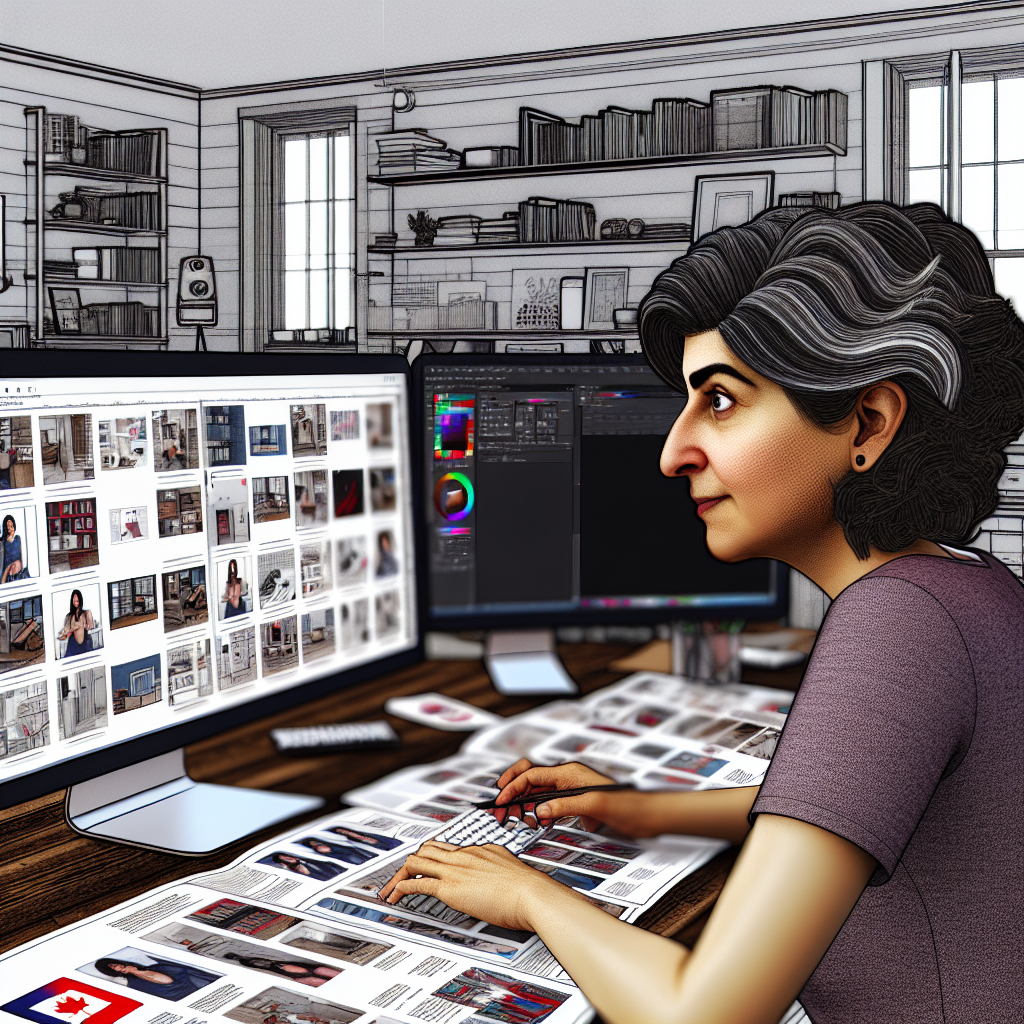Identify Your Unique Style and Niche in Graphic Design
Discovering Your Style
Your design style reflects your unique personality and vision.
Begin by reviewing your previous work.
Note common elements that stand out in your designs.
Ask yourself what themes resonate with you.
Consider colors, typography, and layouts that capture your attention.
Researching Design Niches
Explore different graphic design niches available today.
Popular niches include branding, web design, and print design.
Analyze successful designers in each niche.
This analysis helps you identify where your passion lies.
Finding Inspiration
Draw inspiration from various sources.
Use platforms like Behance and Dribbble to discover innovative designs.
Follow design blogs and social media accounts that inspire you.
Defining Your Target Audience
Your niche will also dictate your target audience.
Identify who you want to serve through your designs.
Understand their preferences and needs.
Tailor your portfolio to attract this specific audience.
Experimenting with Different Techniques
Practice various design techniques to hone your skills.
Experiment with digital tools and traditional methods.
This exploration will help solidify your unique style.
Collecting Feedback
Share your work with peers and mentors.
Request constructive criticism to improve your designs.
Feedback helps you understand how others perceive your work.
Gather and Curate Your Best Work for the Portfolio
Identifying Key Projects
Start by selecting your most impressive projects.
Consider the ones that reflect your skills best.
Choose a diverse range of work to showcase versatility.
Unlock Your Career Potential
Visualize a clear path to success with our tailored Career Consulting service. Personalized insights in just 1-3 days.
Get StartedInclude different mediums, styles, and objectives.
Assessing Quality and Impact
Evaluate each piece based on its quality and impact.
Ask yourself if it garnered positive feedback.
Determine if the project resonates with your target audience.
Prioritize work that demonstrates problem-solving skills.
Gathering Feedback
Seek input from colleagues or mentors.
Utilize their insights to refine your selection.
Feedback can help identify strengths and weaknesses.
Incorporate constructive criticism for improvements.
Creating a Cohesive Narrative
Your portfolio should tell a story about your journey as a designer.
Arrange your work in a logical order.
Use transitions to guide viewers through your projects.
Highlight how each project contributes to your growth.
Designing the Portfolio Layout
An attractive layout is essential for engaging presentations.
Choose a design that reflects your personal style.
Ensure the layout is user-friendly and easy to navigate.
Consistency in design elements enhances professionalism.
Choose the Right Format: Digital vs. Print Portfolios
Understanding Digital Portfolios
Digital portfolios offer convenience and accessibility.
They allow you to showcase your work to a global audience.
Additionally, you can easily update your projects as you grow.
Platforms like Behance and Adobe Portfolio provide templates.
These platforms also enhance visibility through built-in communities.
Advantages of Digital Portfolios
First, digital portfolios can include interactive elements.
You can incorporate videos and animations to enhance engagement.
Moreover, you can share links to your social media profiles.
This feature builds a cohesive online presence.
Digital portfolios are often more environmentally friendly.
Considering Print Portfolios
Print portfolios present a tangible experience to clients.
They allow potential clients to hold and examine your work directly.
Furthermore, print portfolios stand out during interviews.
Having a physical copy can leave a lasting impression.
Advantages of Print Portfolios
Print portfolios can show your attention to detail.
High-quality paper and prints can reflect your design aesthetics.
Moreover, print allows for a personal touch, such as hand-written notes.
This method fosters deeper connections with clients.
Making the Decision
Ultimately, the choice depends on your target audience.
Consider how your work fits into the digital landscape.
Also, think about the industries you want to reach.
You may even choose to maintain both formats for flexibility.
Find Out More: Exploring the Different Specializations in Graphic Design
Create a Compelling Portfolio Layout and Design
Choosing the Right Format
Your portfolio format shapes the viewer’s impression.
Choose a digital format for accessibility and ease of sharing.
Alternatively, opt for a printed version for in-person presentations.
Both formats should reflect your personal style.
Establishing a Cohesive Theme
A cohesive theme enhances your portfolio’s professionalism.
Select colors that resonate with your design aesthetic.
Additionally, use consistent typography across all pages.
The layout should blend seamlessly with your work.
Organizing Your Projects
Organize your projects logically to guide the viewer.
Consider grouping work by type or industry.
Highlight your best work at the beginning or end.
This approach keeps your audience engaged throughout.
Including Project Descriptions
Every project should include a brief description.
Explain your role in the project to showcase your skills.
Include challenges faced and solutions implemented.
This context adds depth to your portfolio.
Utilizing High-Quality Images
High-quality images elevate the overall appearance of your portfolio.
Use professional photography to showcase your work effectively.
Avoid using low-resolution images, as they detract from quality.
Moreover, ensure that the images are properly cropped and formatted.
Incorporating Personal Branding
Your portfolio is a reflection of your personal brand.
Include a personal logo or signature to enhance identity.
Consider a custom color palette that aligns with your style.
This branding creates a memorable impact on viewers.
Making it Interactive
Interactive elements can make your portfolio more engaging.
Consider adding links to websites or social media profiles.
Incorporate animations subtly to draw attention to key projects.
These features can help showcase your technical skills.
Learn More: The Importance of Archivists in the Digital Age
Incorporate Case Studies to Demonstrate Your Process
Why Case Studies Matter
Case studies showcase your unique creative process.
They illustrate how you approach problems and solutions.
Moreover, they help potential clients understand your value.
Selecting the Right Projects
Choose projects that highlight your skills effectively.
Focus on a variety of design styles and challenges.
Consider including both individual and collaborative works.
Project Variety
- Include print design projects.
- Showcase digital and web design examples.
- Highlight branding and identity projects.
Collaboration Highlights
Feature projects that involved a team or client collaboration.
Explain your role and contributions clearly.
This demonstrates your ability to work with others effectively.
Structuring Your Case Studies
Organize each case study to tell a compelling story.
Start with the project’s background and objectives.
Next, outline your design process and decisions.
Finally, show the results and impact of your work.
Background and Objectives
Provide context about the client and project goals.
Describe any challenges faced at the outset.
Design Process
Outline your approach to tackling the project.
Include sketches or drafts if possible.
This offers insight into your creative thinking.
Results and Impact
Showcase the final result with high-quality visuals.
Include metrics or testimonials to support your claims.
Visual Presentation
Use a clean and cohesive layout for your case studies.
Integrate visuals that complement your written content.
This will enhance readability and engagement.
High-Quality Images
- Use clear images that capture detail and color.
- Consider before-and-after comparisons when applicable.
- Ensure visuals are optimized for quick loading times.
Consistent Typography and Colors
Choose fonts and colors that match your overall portfolio design.
This creates a unified look throughout your case studies.
Final Touches
Review your case studies for clarity and coherence.
Make sure each section flows logically to the next.
Consider seeking feedback from peers or mentors.
You Might Also Like: Mastering Lighting Techniques for Professional Photography

Utilize High-Quality Images and Graphics for Presentation
Importance of Visual Quality
High-quality visuals immediately grab attention.
They set the tone for your portfolio.
Using crisp images enhances your designs.
Moreover, it reflects professionalism and care.
Choosing the Right Images
Select images that complement your work.
They should enhance the story behind your designs.
Additionally, avoid generic stock photos.
Instead, use original photography whenever possible.
Optimizing Images for Web
Always optimize images for web performance.
This ensures fast loading times for your portfolio.
Use formats like JPEG for larger images.
Consider PNG for graphics with transparency.
Creating a Cohesive Look
Maintain a consistent style throughout your portfolio.
Use similar color palettes across all images.
This consistency reinforces your brand identity.
Furthermore, cohesive visuals create a professional appearance.
Including Graphic Design Projects
Showcase a range of graphic design projects.
Include branding, typography, and layout examples.
Diverse work displays your skills effectively.
Highlight projects that received positive feedback.
Updating Your Portfolio Regularly
Regularly update your portfolio with new projects.
Remove older work that no longer represents your style.
This keeps your portfolio fresh and relevant.
Additionally, showcase your best work prominently.
Discover More: Essential Skills Every Graphic Designer Should Master
Include Client Testimonials and Project Outcomes
Client Testimonials
Client feedback is invaluable for showcasing your work.
Happy clients can amplify your credibility as a designer.
Gather testimonials that reflect your impact on their brand.
For example, Sarah Johnson from FreshLeaves said, “The design truly captured our vision.”
Another client, Michael Thompson, remarked, “Your creativity transformed our project completely.”
Include diverse testimonials to appeal to different audiences.
Consider using brief quotes for quick impact.
Display client names and company logos to enhance authenticity.
Finally, ensure you obtain permission before sharing their statements.
Project Outcomes
Highlighting project outcomes adds substance to your portfolio.
Start by outlining the goals for each project.
Then, showcase measurable results achieved through your designs.
For instance, an increase in user engagement can impress potential clients.
Another successful outcome might be a boost in sales post-redesign.
Utilize graphics and charts to visualize numerical data effectively.
Consider using case studies for more detailed insights.
Clearly link your design work to the project’s success.
Finally, communicate both qualitative and quantitative results.
Regularly Update and Refresh Your Portfolio to Reflect Growth
Evaluate Your Current Work
Begin by assessing your existing portfolio.
Identify pieces that showcase your best work.
Consider what projects truly represent your skills.
Also, note any outdated styles or designs.
Add New Projects
Continuously incorporate new projects into your portfolio.
Highlight recent skills and techniques you have developed.
These additions reflect your current level of expertise.
Include work that aligns with your desired career path.
Remove Underperforming Pieces
Be willing to let go of weaker works.
Removing underperforming pieces strengthens your portfolio.
This helps maintain a high-quality presentation.
Regular reviews keep your portfolio fresh and relevant.
Seek Feedback
Request feedback from peers and mentors.
External insights can reveal strengths and weaknesses.
Act on constructive criticism to improve your work.
Adjust your portfolio based on this feedback.
Showcase Your Growth
Clearly demonstrate your skill evolution over time.
Consider creating a timeline of your work.
This visual representation highlights your development.
It can make a significant impact on potential clients.
Maintain Consistent Branding
Ensure your portfolio maintains a cohesive style.
Your branding should reflect your unique identity.
Use consistent colors, fonts, and layouts throughout.
This unification creates a professional appearance.




